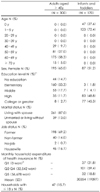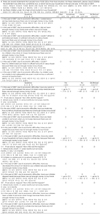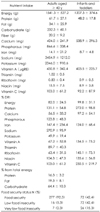Abstract
This study aims to develop an index of food security in order to assess food security status in Korea and to evaluate reliability and validity of the index. The index of food security was developed based on the US Household Food Security Survey Module (US-HFSS). After the US-HFSS was translated and back-translated, it was evaluated and modified by a focus interview for experts. The developed Korean Household Food Security Survey Module (K-HFSS) was tested by cognitive interviews and a pretest for general community population to assess its application for Korean population. For the reliability and validity of K-HFSS, the survey was conducted with 300 adults aged 40 years or more living in a rural community and 212 infants and toddlers living in an urban community. The reliability was assessed by Cronbach' alpha and the validity was evaluated by content validity, construct validity, and criterion-related validity. The questionnaire items of K-HFSS were partly modified, accounting for Korean social and cultural backgrounds and adapted by general community population. The reliability was relatively high, showing Cronbach' alpha coefficients ranged from 0.80 (for adults) to 0.87 (for infants and toddlers). The content and construct validities were all acceptable. The result of criterion-related validity showed that food security status was significantly related to the household income level. In conclusion, the K-HFSS would be used as a reliable and valid instrument to assess food security status in parts of the Korean population.
Figures and Tables
Fig. 1
Food security scale item response curves across household expenditure of health insurance strata in infants and toddlers (n = 170). Q1: first quintile based on the household expenditure of health insurance, Q2-Q4: second-fourth quintile, Q5: fifth Quintile.

Table 6
Nutrient intakes and household expenditure of health insurance by food security level

1) Mean ± SE of percentage attainment of recommendation based on Dietary Reference Intake (DRI) for Korean after adjusting for age
2) Proportion of subjects who intake nutrients less than the Estimated Average Requirements (EAR) of DRI
3) Mean ± SE
4) The proportion of subjects included in the each quintile
5) a,bSignificant difference by education level at p < 0.05 by Tukey's test, using general linear model
6) FS: Food security, FIS: Food insecurity
References
1. Kim K, Kim MK, Shin YJ. The concept and measurement of food security. J Prev Med Public Health. 2008. 41(6):387–396.

2. FAO. The state of food insecurity in the world 2001. 2002. Rome, Italy: Food and Agriculture Organization in the United Nations.
3. Wunderlich GS, Norwood JL. Food insecurity and hunger in the United States: An assessment of the measure. Panel to Review U.S. Department of Agriculture's Measurement of Food Insecurity and Hunger. 2006. National Research Council.
4. FAO. Rome declaration on world food security and world food summit plan of action (World Food Summit); 1996 November 13-17. 1996. In : Food and Agriculture Organization of the United Nations; Rome, IT. Rome.
5. Habicht JP, Pelto G, Frongillo EA, Rose D. Conceptualization and instrumentation of food insecurity. Proceedings of the Workshop on the Measurement of Food Insecurity and Hunger; 2004 July 15. 2004. In : National Academy Press; Washington, EC. Washing, DC. 1–18.
6. Riely F, Mock N, Cogill B, Bailey L, Kenefick E. Food security indicators and framework for use in the monitoring and evaluation of food aid programs. Food and Nutrition Technical Assistance Project (FANTA), Academy for Educational Development, U.S. Agency for International Development. 1999. No. HRN-A-00-98-00046-00.
7. Rose D, Oliveira V. Nutrient intakes of individuals from foodinsufficient households in the United States. Am J Public Health. 1997. 87(12):1956–1961.

8. Tarasuk VS, Beaton GH. Women's dietary intakes in the context of household food insecurity. J Nutr. 1999. 129(3):672–679.

9. Bhattacharya J, Currie J, Haider S. Poverty, food insecurity, and nutritional outcomes in children and adults. J Health Econ. 2004. 23(4):839–862.

10. Casey PH, Szeto K, Lensing S, Bogle M, Weber J. Children in food-insufficient, low-income families: prevalence, health, and nutrition status. Arch Pediatr Adolesc Med. 2001. 155(4):508–514.
11. Kirkpatrick SI, Tarasuk V. Food insecurity is associated with nutrient inadequacies among Canadian adults and adolescents. J Nutr. 2008. 138(3):604–612.

12. Lee JS, Frongillo EA Jr. Factors associated with food insecurity among U.S. elderly persons: importance of functional impairments. J Gerontol B Psychol Sci Soc Sci. 2001. 56(2):S94–S99.

13. Lee JS, Frongillo EA Jr. Nutritional and health consequences are associated with food insecurity among U.S. elderly persons. J Nutr. 2001. 131(5):1503–1509.

14. Oh SY, Hong MJ. Food insecurity is associated with dietary intake and body size of Korean children from low-income families in urban areas. Eur J Clin Nutr. 2003. 57(12):1598–1604.

15. Olson CM. Nutrition and health outcomes associated with food insecurity and hunger. J Nutr. 1999. 129:2S Suppl. 521S–524S.

16. Cook JT, Frank DA, Berkowitz C, Black MM, Casey PH, Cutts DB, et al. Food insecurity is associated with adverse health outcomes among human infants and toddlers. J Nutr. 2004. 134(6):1432–1438.

17. Klesges LM, Pahor M, Shorr RI, Wan JY, Williamson JD, Guralnik JM. Financial difficulty in acquiring food among elderly disabled women: results from the Women's Health and Aging Study. Am J Public Health. 2001. 91(1):68–75.

18. Nelson K, Cunningham W, Andersen R, Harrison G, Gelberg L. Is food insufficiency associated with health status and health care utilization among adults with diabetes? J Gen Intern Med. 2001. 16(6):404–411.

19. Vozoris NT, Tarasuk VS. Household food insufficiency is associated with poorer health. J Nutr. 2003. 133(1):120–126.

20. Alaimo K, Olson CM, Frongillo EA Jr, Briefel RR. Food insufficiency, family income, and health in US preschool and school-aged children. Am J Public Health. 2001. 91(5):781–786.

21. Wilde PE, Peterman JN. Individual weight change is associated with household food security status. J Nutr. 2006. 136(5):1395–1400.

22. Sarlio-Lahteenkorva S, Lahelma E. Food insecurity is associated with past and present economic disadvantage and body mass index. J Nutr. 2001. 131(11):2880–2884.

23. Gulliford MC, Nunes C, Rocke B. Food insecurity, weight control practices and body mass index in adolescents. Public Health Nutr. 2006. 9(5):570–574.

24. Kim KR, Frongillo EA. Participation in food assistance programs modifies the relation of food insecurity with weight and depression in elders. J Nutr. 2007. 137(4):1005–1010.

25. Alaimo K, Olson CM, Frongillo EA Jr. Food insufficiency and American school-aged children's cognitive, academic, and psychosocial development. Pediatrics. 2001. 108(1):44–53.

26. Alaimo K, Olson CM, Frongillo EA. Family food insufficiency, but not low family income, is positively associated with dysthymia and suicide symptoms in adolescents. J Nutr. 2002. 132(4):719–725.

27. Whitaker RC, Phillips SM, Orzol SM. Food insecurity and the risks of depression and anxiety in mothers and behavior problems in their preschool-aged children. Pediatrics. 2006. 118(3):e859–e868.

28. Nelson K, Brown ME, Lurie N. Hunger in an adult patient population. JAMA. 1998. 279(15):1211–1214.

29. Roe DA. In-home nutritional assessment of inner-city elderly. J Nutr. 1990. 120:Suppl 11. 1538–1543.

30. Hamelin AM, Habicht JP, Beaudry M. Food insecurity: consequences for the household and broader social implications. J Nutr. 1999. 129:2S Suppl. 525S–528S.

31. Walker D, Beauchene RE. The relationship of loneliness, social isolation, and physical health to dietary adequacy of independently living elderly. J Am Diet Assoc. 1991. 91(3):300–304.

32. Vailas LI, Nitzke SA, Becker M, Gast J. Risk indicators for malnutrition are associated inversely with quality of life for participants in meal programs for older adults. J Am Diet Assoc. 1998. 98(5):548–553.

33. Adams EJ, Grummer-Strawn L, Chavez G. Food insecurity is associated with increased risk of obesity in California women. J Nutr. 2003. 133(4):1070–1074.

34. Alaimo K, Olson CM, Frongillo EA Jr. Low family income and food insufficiency in relation to overweight in US children: is there a paradox? Arch Pediatr Adolesc Med. 2001. 155(10):1161–1167.

35. Casey PH, Simpson PM, Gossett JM, Bogle ML, Champagne CM, Connell C, et al. The association of child and household food insecurity with childhood overweight status. Pediatrics. 2006. 118(5):e1406–e1413.

36. Townsend MS, Peerson J, Love B, Achterberg C, Murphy SP. Food insecurity is positively related to overweight in women. J Nutr. 2001. 131(6):1738–1745.

37. Siefert K, Heflin CM, Corcoran ME, Williams DR. Food insufficiency and the physical and mental health of low-income women. Women Health. 2001. 32(1-2):159–177.

38. Kleinman RE, Murphy JM, Little M, Pagano M, Wehler CA, Regal K, et al. Hunger in children in the United States: potential behavioral and emotional correlates. Pediatrics. 1998. 101(1):E3.

39. Murphy JM, Wehler CA, Pagano ME, Little M, Kleinman RE, Jellinek MS. Relationship between hunger and psychosocial functioning in low-income American children. J Am Acad Child Adolesc Psychiatry. 1998. 37(2):163–170.

40. Hamilton WL, Cook JT, Thompson WW, Buron LF, Frongillo EA, Olson CM. Household food security in the United States in 1995. Summary report of the food security measurement project. U.S. Department of Agriculture. 1997.
41. Nord M, Andrews M, Carlson S. Household food security in the United States in 2005. U.S. Department of Agriculture. 2006.
42. FAO. Measurement and assessment of food deprivation and undernutrition. International Scientific Symposium, Food and Agriculture Organization of the United Nations. 2002. Rome:
43. Bickel G, Nord M, Price C, Hamilton WL, Cook JT. Measuring food security in the United States. Guide to measuring household food security. 2000. Office of Analysis, Nutrition, and Evaluation, Food and Nutrition Service, U.S. Department of Agriculture;Available from URL:
http://www.fns.usda.gov/fsec/FILES/FSGuide.pdf.
44. Wunderlich GS, Norwood JL, editors. National Research Council. Panel to Review U.S. Department of Agriculture's Measurement of Food Insecurity and Hunger. Committee on National Statistics, Division of Behaviroal and Social Science and Education. Food insecurity and hunger in the United States: An assessment of the measure. 2006. Washington, DC: The National Academies Press.
45. Coates J, Frongillo EA, Rogers BL, Webb P, Wilde PE, Houser R. Commonalities in the experience of household food insecurity across cultures: what are measures missing? J Nutr. 2006. 136(5):1438S–1448S.

46. Anderson SA. Core indicators of nutritional state for difficult-tosample populations. J Nutr. 1990. 120:Suppl 11. 1559–1600.
47. Chaiy SI. Research methods for social science. 2004. Seoul: Hak-Hyun Press.
48. Fowler FJ. Wiley SP. Getting beyond pretesting and cognitive interviews: The case for more experimental pilot studies. Questionnaire development evaluation and testing methods. 2004. New York: Wiley.
49. Groves RM, Graham K, K. RJN, Norbert S, Christopher S. Forsyth BH, Rothgeb J, Willis G, editors. Methods for testing and evaluating survey questionnaires. Does pretesting make a difference? An Experimental test. 2004. John Wiley & Sons;525–546.
50. Jobe JB, Mingay DJ. Cognitive research improves questionnaires. Am J Public Health. 1989. 79(8):1053–1055.

51. Willis GB. Cognitive Interviewing - A "How to" Guide. 1999. Research Triangle Institute. National Cancer Institute.
52. Kim KS. Analysis Structural Equation Modeling. 2004. Seoul: Data Solution Publishers.
53. Radimer KL, Olson CM, Campbell CC. Development of indicators to assess hunger. J Nutr. 1990. 120:Suppl 11. 1544–1548.

54. Food and Agriculture Organization of the United Nations. Proceedings Measurement and Assessment of Food Deprivation and Undernutrition (International Scientific Symposium); 2002 June 26-28. 2003. Rome, IT. Rome: Food and Agriculture Organization of the United Nations.
55. Frongillo EA Jr. Validation of measures of food insecurity and hunger. J Nutr. 1999. 129:2S Suppl. 506S–509S.

56. Kendall A, Olson CM, Frongillo EA Jr. Validation of the Radimer/ Cornell measures of hunger and food insecurity. J Nutr. 1995. 125(11):2793–2801.
57. Coates J, Wilde PE, Webb P, Rogers BL, Houser RF. Comparison of a qualitative and a quantitative approach to developing a household food insecurity scale for Bangladesh. J Nutr. 2006. 136(5):1420S–1430S.

58. Frongillo EA, Nanama S. Development and validation of an experience-based measure of household food insecurity within and across seasons in northern Burkina Faso. J Nutr. 2006. 136(5):1409S–1419S.

59. Gonzalez W, Jimenez A, Madrigal G, Munoz LM, Frongillo EA. Development and validation of measure of household food insecurity in urban Costa Rica confirms proposed generic questionnaire. J Nutr. 2008. 138(3):587–592.

60. Perez-Escamilla R, Segall-Correa AM, Kurdian Maranha L, Sampaio Md, Marin-Leon L, Panigassi G. An adapted version of the U.S. Department of Agriculture Food Insecurity module is a valid tool for assessing household food insecurity in Campinas, Brazil. J Nutr. 2004. 134(8):1923–1928.

61. Melgar-Quinonez HR, Zubieta AC, MkNelly B, Nteziyaremye A, Gerardo MF, Dunford C. Household food insecurity and food expenditure in Bolivia, Burkina Faso, And the Philippines. J Nutr. 2006. 136(5):1431S–1437S.

62. Korea Health Industry Development Institute. In-depth analysis on the 3rd (2005) Korea Health and Nutrition Examination Survey - Nutrition Survey. 2007. Seoul, Korea: Korea Health Industry Development Institute.




 PDF
PDF ePub
ePub Citation
Citation Print
Print







 XML Download
XML Download